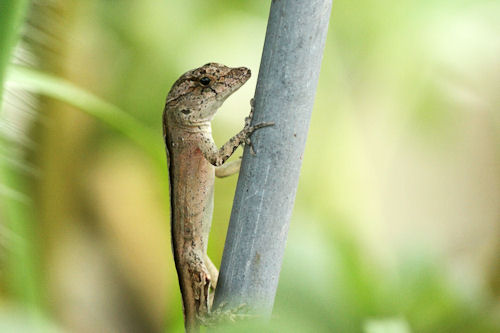
Little guys like it narrow. Photo from Daffodil’s Photo Blog.
The influence of habitat use on ecological and evolutionary patterns in Anolis lizards is well documented. Despite extensive work on interspecific variation, how habitat use varies within a species is relatively understudied.
As part of my master’s work in Dan Warner’s lab, we caught and recorded the perch height, width, and substrate (i.e., ground vs. vegetation) of 717 brown anoles (A. sagrei) on a small island in the Halifax River, near Ormond Beach, Florida. The island consisted of two main habitat types (open-canopy and forest) with an intermediate between the two.

Fig 1. Effects of age class on (a) perch height and (b) perch diameter, and the effects of macrohabitat on (c) perch height and (d) perch diameter.
We found that adults used higher (Fig. 1a) and thicker (Fig. 1b) perches than juveniles, and adult males perched higher than adult females (Fig. 1a). Juveniles also occurred more frequently on the ground. Adults may benefit by using more conspicuous perches that increase visibility for social communication whereas juveniles are likely to benefit by using microhabitats that reduce predation-risk. In addition, we found that lizards in the forest used higher (Fig. 1c) and thicker (Fig. 1d) perches than those in the open-canopy and intermediate habitats, likely due to variation in perch availability.
Interestingly, juvenile body size increased throughout habitat zones moving away from the forest, but this trend was reversed for adults (Fig. 2). This may suggest that juveniles hatch in forested habitat (where we have found many nest-sites), migrate out to open-canopy areas to mature, and then move back to the forest as large adults. A similar shift in habitat use has been reported by Stamps for Anolis aeneus (1983).
We also returned three and eight months later to recapture lizards and assess survival. We found that large individuals of both age classes had increased survival from July to October (Fig. 3a & b). Body size did not influence overwinter survival. However, lizards that used relatively low perches had increased overwinter survival (Fig. 3c).

Fig 3. Probability of survival for (a) adults from July-October, (b) juveniles from July-October, and (c) adults overwinter in relation to standardized SVL (left column) and perch height (right column).
Several factors could be responsible for the age- and sex-specific habitat variation observed in this species. However, future experimental approaches are needed to fully understand the causal factors contributing to this variation. I have conducted two competition experiments and hope to report on those findings in the near future!
The results of this post can be found in:
Delaney, D.M. and D.A. Warner. 2016. Age- and sex-specific variations in microhabitat and macrohabitat use in a territorial lizard. Behavioral Ecology and Sociobiology doi: 10.1007/s00265-016-2121-3
Also referenced:
Stamps, J.A. 1983. The relationship between ontogenetic habitat shifts, competition and predator avoidance in a juvenile lizard (Anolis aeneus). Behavioral Ecology and Sociobiology 12:19-33.
- SICB 2018: When the Lights Go Up in the City - January 9, 2018
- SICB 2018: Moms Help Embryos Beat the Heat - January 8, 2018
- Effects of Age- and Sex-specific Density on Behaviour and Survival of the Brown Anole - June 11, 2017



George Gorman
This has been previously noted, but perhaps not “studied” in other species. In what admittedly might be called some “quick and dirty observations”, probably without statistical significance , we wrote that , with respect to diurnal perch sites, male Anolis monensis tended to perch on higher and wider perches than “female sized” individuals ; and “juveniles” (=individuals smaller than adult females) were more likely than either class to be found between ground and two feet. We also noted that at night, juveniles were more likely to be found than adults…probably because they were sleeping lower to the ground – G.Gorman and B.Stamm, 1975,
J. Herpetol. 9(2):197-205.
In that paper we cited Laska , 1970, Breviora M.C.Z. 349:1-6 who demonstrated a sexual difference in perch height in A. scriptus.
David Delaney
Thanks for the info and citations, Dr. Gorman!
In the paper we mention similar shifts in age-class habitat use by A. carolinensis, A. hendersoni, and A. nebulosus, as well as other lizard genera (Iguana iguana and Chamaeleo chamaeleon).
Bob Powell
If you carefully go through Henderson and Powell (2009. Natural History of West Indian Reptiles and Amphibians), you’ll find references to a number of studies of anoles (and a few other species) in which age class and sex were studied in relation to habitat.